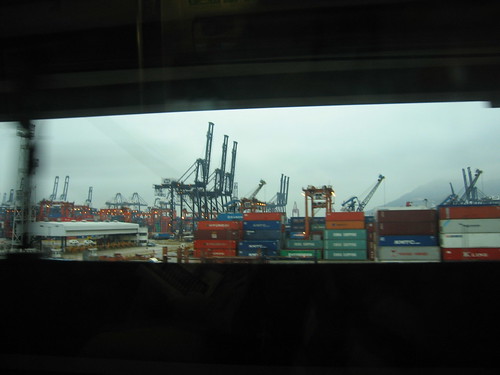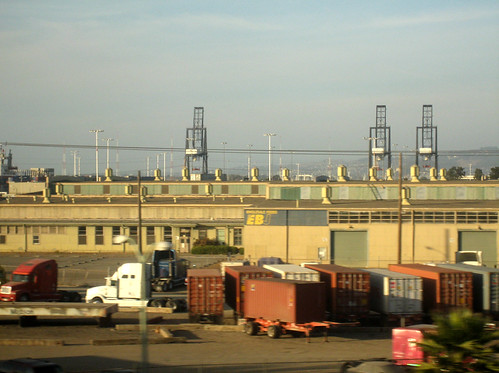contain yourself
Container shipping is awesome. The containers themselves look like colorful building blocks, but they're hardly playthings. Without them, globalization would not exist as we know it today.
 Photo by MarielleDeLosAngeles
Photo by MarielleDeLosAngeles
In 1956, the first container ship set sail from Newark for Houston with 58 standard inter-modal containers. Today, 90% of the world's manufactured cargo is carried in containers -- in 2005 18 million containers were carried on the world's ships, trucks and trains.
 Kowloon Container Port in Hong Kong, China
Kowloon Container Port in Hong Kong, China
Unlike the infamous urban docks of the 1800's, the container ports of the 21st century are places of precision. The giraffe-like gantry cranes that ring every container port hoist containers directly onto trucks, trains, and shuttles. The entire process is conducted without goods ever leaving the containers and cargo is loaded and unloaded at an unprecedented pace.
 Port of Oakland from BART
Port of Oakland from BART
Perhaps due to the specificity of their design, container ports are particularly susceptible to disasters. In 1995, the Great Hanshin earthquake hit Kobe Japan, one of the world's busiest container ports.
The earthquake turned reclaimed land around the city's waterfront to mush: retaining walls tilted towards the sea and the ground level dropped. Almost all of Kobe's 77 gantry cranes were rendered inoperable, their outer legs perched on the retaining walls and their inner legs sinking into the fill.
 Kobe, Japan (1995)
Kobe, Japan (1995)
Container ports are also a US national security vulnerability. Their whole advantage, however, lies in operating at an efficiency that even the smoothest bureaucracy would have trouble keeping up with.
Earlier this year, Congress indirectly prevented a Dubai-based company from operating U.S. container ports. This jingoistic maneuver, which provided a false sense of security but little else, highlights the challenges of creating effective security policies for container ports.
 Port Elizabeth, New Jersey
Port Elizabeth, New Jersey
One of the best ideas in containers is just that. In 2001, Australian architect Sean Godsell came up with the Future Shack, a temporary housing unit recycled from an old cargo container. Self contained, easily transportable, and assembled in less than 24 hours, it has potential to help nations deal with disasters that displace large populations -- disasters like Hurricane Katrina or the 2004 Indian Ocean Tsunami.
 Godsell has also designed a Bus Shelter House where the homeless can spend a night in comfort.
Godsell has also designed a Bus Shelter House where the homeless can spend a night in comfort.
On the one hand, designing with containers seems to somehow miss the point. Containers are just part of a system -- it is the design of the system that can change the world. On the other hand, maybe container-based designs could lead to the greater globalization of ideas, not just products.
 Photo by MarielleDeLosAngeles
Photo by MarielleDeLosAngelesIn 1956, the first container ship set sail from Newark for Houston with 58 standard inter-modal containers. Today, 90% of the world's manufactured cargo is carried in containers -- in 2005 18 million containers were carried on the world's ships, trucks and trains.
 Kowloon Container Port in Hong Kong, China
Kowloon Container Port in Hong Kong, ChinaUnlike the infamous urban docks of the 1800's, the container ports of the 21st century are places of precision. The giraffe-like gantry cranes that ring every container port hoist containers directly onto trucks, trains, and shuttles. The entire process is conducted without goods ever leaving the containers and cargo is loaded and unloaded at an unprecedented pace.
 Port of Oakland from BART
Port of Oakland from BARTPerhaps due to the specificity of their design, container ports are particularly susceptible to disasters. In 1995, the Great Hanshin earthquake hit Kobe Japan, one of the world's busiest container ports.
The earthquake turned reclaimed land around the city's waterfront to mush: retaining walls tilted towards the sea and the ground level dropped. Almost all of Kobe's 77 gantry cranes were rendered inoperable, their outer legs perched on the retaining walls and their inner legs sinking into the fill.
 Kobe, Japan (1995)
Kobe, Japan (1995)Container ports are also a US national security vulnerability. Their whole advantage, however, lies in operating at an efficiency that even the smoothest bureaucracy would have trouble keeping up with.
Earlier this year, Congress indirectly prevented a Dubai-based company from operating U.S. container ports. This jingoistic maneuver, which provided a false sense of security but little else, highlights the challenges of creating effective security policies for container ports.
 Port Elizabeth, New Jersey
Port Elizabeth, New JerseyOne of the best ideas in containers is just that. In 2001, Australian architect Sean Godsell came up with the Future Shack, a temporary housing unit recycled from an old cargo container. Self contained, easily transportable, and assembled in less than 24 hours, it has potential to help nations deal with disasters that displace large populations -- disasters like Hurricane Katrina or the 2004 Indian Ocean Tsunami.
 Godsell has also designed a Bus Shelter House where the homeless can spend a night in comfort.
Godsell has also designed a Bus Shelter House where the homeless can spend a night in comfort.On the one hand, designing with containers seems to somehow miss the point. Containers are just part of a system -- it is the design of the system that can change the world. On the other hand, maybe container-based designs could lead to the greater globalization of ideas, not just products.

1 comment:
I think one of the strengths of architects and desigers considering shipping containers is that the critical aspects of the mass production and transportability have already been successfully resolved. Architects are also, IMO, more successful when designing with fixed parameters - they are better able to focus their energy, instead of coming up with answers to questions not asked. The beauty of the shipping container is it's fixed dimensions and integral structure. The possibilities of outfitting the cubic space are nearly infinite, which is exciting and inspiring partially because you know if you follow the few rules, it will stand up and can be transported nearly anywhere on the globe.
Thanks for this interesting entry!
Post a Comment